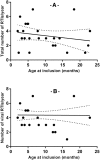Viral respiratory tract infections in young children with cystic fibrosis: a prospective full-year seasonal study
- PMID: 31481063
- PMCID: PMC6724274
- DOI: 10.1186/s12985-019-1208-7
Viral respiratory tract infections in young children with cystic fibrosis: a prospective full-year seasonal study
Abstract
Background: Viral respiratory tract infections are common during early childhood. How they impact cystic fibrosis lung disease history in young children is poorly known. The principal aim of our study was to determinate respiratory tract infections frequency in this cystic fibrosis young population. Secondary outcomes were nature of viral agents recovered and impact of such infections.
Methods: We conducted a prospective cohort study of 25 children affected by cystic fibrosis and aged less than 2 years. Nasal samplings were taken systematically monthly or bimonthly with additional samples taken during respiratory tract infections episodes. Ten pathogens were tested by a combination of five duplex RT-PCRs or PCRs: influenza A and B, respiratory syncytial virus (RSV), metapneumovirus (MPV), rhinovirus/enterovirus (RV/EV)), coronavirus (HKU1, NL63, 229E and OC43), parainfluenza virus (1-4), adenovirus and bocavirus (Respiratory Multi-Well System MWS r-gene®, BioMérieux, Marcy l'Étoile, France). Cycle thresholds (CTs) were reported for all positive samples and considered positive for values below 40. Quantitative variables were compared using a nonparametric statistical test (Wilcoxon signed rank for paired comparisons). Pearson's correlation coefficient (r) was used to assess relationships between two variables. Statistical analyses were performed using SAS v9.4 (SAS Institute, Cary, NC, USA) or GraphPad Prism V6.00 (GraphPad Software, La Jolla, CA, USA). The significance level was set at 0.05.
Results: The mean age at inclusion was 9.6 ± 6.7 months. The patients had 3.4 ± 1.7 respiratory tract infections episodes per child per year. Forty-four respiratory tract infections (69%) were associated with virus: rhinovirus and enterovirus (RV/EV) were implied in 61% of them and respiratory syncytial virus (RSV) in 14%. Only one patient required hospitalization for lower respiratory tract infections. 86% of the patients were treated by antibiotics for a mean of 13.8 ± 6.2 days. RSV infections (n = 6) were usually of mild severity.
Conclusions: Respiratory tract infections in young children with cystic fibrosis were of mild severity, rarely requiring hospitalization. Unsurprisingly, RV/EV were the most frequent agents. RSV-related morbidity seems low in this population. This raises the question of the usefulness of RSV preventive medication in this young population.
Keywords: Children; Cystic fibrosis; Respiratory virus.
Conflict of interest statement
The authors declare that they have no competing interests.
Figures
References
Publication types
MeSH terms
LinkOut - more resources
Full Text Sources
Medical
Research Materials



